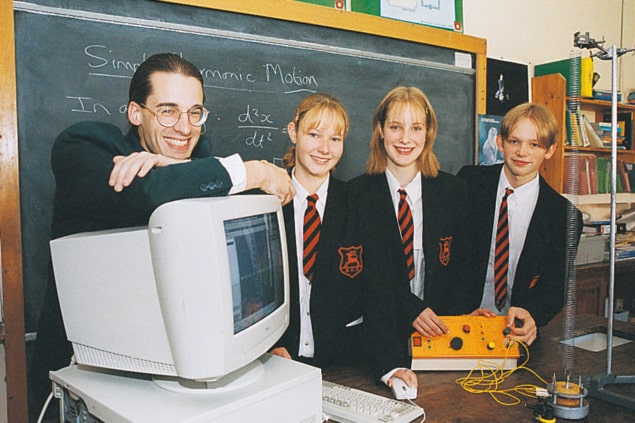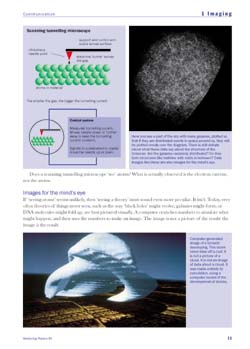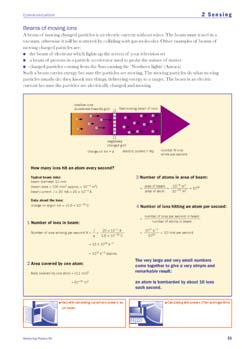Physics teaching is being transformed in the UK and the Institute of Physics is leading the way with a forward-looking initiative designed to revitalize the subject and attract more students

LAST month some 600 students in 25 schools and colleges across the UK began piloting a completely new physics course for 16-19 year olds, called Advancing Physics. The course is part of a £1m initiative by the Institute of Physics, in partnership with the OCR examination board, to make physics teaching more up to date, more exciting and more relevant to all aspects of modern life. It is backed by funding from the Institution of Electrical Engineers, the Particle Physics and Astronomy Research Council, and various industrial sponsors.
Classroom visit
Imagine you are visiting a class that is just starting the Advancing Physics course. You sit by a student who “calls up” on a computer screen an image of the planet Mercury that was transmitted to Earth by the Voyager spacecraft. The image is speckled with noise that was introduced during the transmission. Deftly, the student selects an option to process the image, and most of the random noise is removed. Nearby, another student looks at an X-ray image of a skull with a barely visible hairline fracture, and enhances the contrast of the image to bring the fracture into view.
The teacher quizzes the students about how image processing works. The students talk confidently about images made of pixels, each storing and displaying one byte of data. One student explains how replacing the value stored in a pixel with the median of it and surrounding pixels is a good way to remove noise. The teacher points out the connection with averaging over a set of experimental data. The students know what they are doing because they have previously “looked under the bonnet” of image-processing software, understanding how smoothing and edge detection work by using a spreadsheet.

Images from medical physics (such as ultrasound scans, X-rays and magnetic-resonance images) and from modern areas of research like astronomy and space science are available to students on the CD-ROM that is an integral part of the new course. The CD-ROM also contains the scientific image-processing software they use.
In another class along the corridor, the new Advancing Physics students begin studying the properties and uses of a wide variety of materials, such as metals, ceramics, polymers and composites. These students are working towards the concept of “designer materials” in which an understanding of the relations between the structure and properties enables new materials to be created to specification, sometimes even by building them atom by atom. The students have access to images of microstructures within materials, and a database containing the properties of a wide range of substances (figure 1). Models and simulations, all of which are a click or two away on the CD-ROM, also aid the students.
Both of these starting points reflect the latest aspects of physics in action. And both connect to issues of social importance that the students are eager to discuss, such as the uses and abuses of digitized images in newspaper reporting, the digital revolution in communication, and the creation and marketing of new fabrics, electronic devices and stronger materials. This is the world in which these students will live, having to judge whether changes are really of benefit or merely serve to create and satisfy passing fads. The new course provides space for students to put forward their own opinions and ideas, underpinning them with information and an understanding of the physical concepts.
The students have a specially written textbook that is full of visual appeal and tells physics as an engaging story (figure 2). It contains plenty of “hard physics” and all the relevant mathematics, which is often presented with strong visual enhancements (figure 3). But the narrative is about ideas, discoveries and inventions as they happened, the people involved, and human purposes and consequences. It is this narrative that holds all the physical concepts together and creates interest among the students.
The textbook is slimline, while the CD-ROM contains additional exercises and activities as well as images and computer programs, including models and data. The CD-ROM also contains additional support for weaker students and more advanced material for stronger ones.
As with every A-level course, Advancing Physics by no means neglects the traditional core topics, such as mechanics, optics, electricity and magnetism, and thermodynamics. (A-levels are the exams taken in the UK by 18 year olds hoping to go to university.) Indeed, the Qualification and Curriculum Authority (QCA) only approves A-level courses that meet a rigorous set of criteria, one of which is that these fundamental topics make up 60% of the course content.
All change for A-levels
Many Physics World readers in the UK will know that A-levels in every subject will change next year. Instead of a two-year course that leads to an A-level qualification, there will be an initial one-year Advanced Subsidiary (AS) course and qualification. Students will then be able to continue for a second year if they wish, and sit a second examination. The two add up to the equivalent of a full A-level.
At present, students usually take between two and four A-levels, but under the new system they will be able to broaden their post-16 education by taking additional AS courses that they do not continue to A-level. This may bring students in England, Wales and Northern Ireland into line with their counterparts in Scotland and other European countries.

Physics is fortunate in having more than one innovative and well thought through initiative that will be ready to meet these new and challenging demands. The Salters-Horners course, which has been on trial for a year, capitalizes on students’ interests in the real-life use of science and illustrates physical concepts through a variety of applications. Teachers who want to know more about the Salters-Horners approach can obtain the pilot student textbooks and teachers’ guides, which are published by Heinemann.
The Institute of Physics initiative provides a further choice for teachers and students. Advancing Physics is designed to make physics attractive to as many people as possible, while remaining true to the soul of the subject. In particular, the course is designed to provide a really worthwhile one-year AS course that gives a broad picture of what physics is all about. Furthermore, the AS course is genuinely valuable to those who go no further and is an effective starting point for those who do.
Broadening the A-level system has been on the agenda for the UK government for at least a generation, but proposal after proposal has not quite come to fruition. Only now has the government committed itself to change. Meanwhile, students have taken matters into their own hands, broadening their post-16 education by increasingly choosing “mixed” combinations of arts and science subjects. Indeed, around 40% of all A-level students take a mixture of subjects.
Physics is evidently at risk when students look to broaden their choices because of its strong links with mathematics. Now it is essential to consider how the equivalent to A-level physics can be taught without students invariably studying mathematics to an advanced level. Mathematics features strongly in the Advancing Physics course, and students are given strong support in the maths that is relevant to their physics course. The new one-year AS courses offer a real opportunity to attract a wider variety of students to the subject.
The Institute of Physics post-16 initiative has much wider objectives than simply producing a new A-level physics course. It is imperative for those in the physics and engineering communities to have a say in the development of physics education during these changing and challenging times. We cannot afford for the future of physics education to be decided by government quangos without attempting to shape the arguments they take into account.
In order to recapture the influence that physicists once had in deciding educational policy, we must have good arguments and present them to the public in attractive and digestible forms. The Institute of Physics has therefore commissioned a “discussion series” of five booklets, entitled Shaping the Future, which discuss topics of major concern about the shape of post-16 physics. Three booklets in the discussion series have already been published: Making Physics Connect, Physics in Mathematical Mood and Physics in Vocational Courses. Two more are in preparation: The Study of Matter and Physics in a Broader Context.
Each booklet forms part of an on-going debate about the way forward for physics education in the next decade. As each booklet is being written, national meetings are held to discuss and refine the content. And the lively points that arise as a result are included in the final version. Each booklet is being sent to significant opinion-forming and decision-making bodies, including government regulatory bodies such as the QCA, who have welcomed them. The booklets have also been made available to groups of teachers around the country who continue to discuss the points they raise.
A-level physics made new
The urgent need to create the new A-level physics courses and to attract more students to the subject demands that we rethink post-16 physics education. It is essential to make the subject more attractive, while making sure that it remains true to itself. Students deserve a clearer picture of the many things physics can offer, both by way of personal and intellectual satisfaction, and by way of the enormous number of interesting and productive careers.
One example is the growing importance of “visualization” as a way of dealing with complex data and as a way of understanding complex systems such as the evolution of galaxies and the structures of atoms and molecules. Equally, the ability to visualize different parts of the body is crucial in medical imaging. While such images are attractive and create a lasting impression on students, they also provide an insight into how modern physics is done and how it makes essential use of computing. The new A-level physics courses need to be organized around a number of themes of this kind – for example instrumentation and sensing, structures and uses of materials, models and computing – which can both draw students in and point the way forward.
Variety must surely play a key role in making physics attractive. Fortunately the subject can offer a great deal of variety, from skilful experimenting to careful mathematical deduction; from designing new devices of practical use to inventing new ways to describe the world; from accounting for simple phenomena of everyday life to making sense of things never seen. Physics has much to offer those who want to make a difference to other peoples’ lives, but equally it has much to offer those who want to understand nature in as fundamental a way as possible. All of these needs must be reflected in a well designed A-level physics course (see ).
Students will find physics more attractive if they feel more involved. That means getting students to choose a topic to study by themselves. For this reason, visitors to a class following the Advancing Physics course might hear a student giving a talk about fibres in modern fabrics, or about designing a semiconductor material. Other students might have prepared posters or Web pages about their chosen subject. Their work will be assessed as part of the examination, and will take into account their developing ability to communicate and the way they have set the science or technology in a wider context.
Rethinking mathematics and practical work
Drop in on the class and you might find students plotting quantities, such as the strength or electrical conductivity of materials or the sizes of objects from atoms to galaxies, on a logarithmic scale. They would be discussing how on this kind of scale equal steps represent equal multiples (they might informally call the scale a “times” scale); why the scale has no “zero”; taking pleasure in writing 1 on the scale as 100. Later work will take equal care with other functions, particularly exponential and sinusoidal functions. The consequences of using the reciprocal function, for instance, will be brought out through examples such as the focal length and power of a lens, and the conductivity and resistivity of a material, not to mention speed and journey time.

When planning the Advancing Physics course, we decided that we must be very positive about mathematics in physics. Students should not see mathematics as a necessary evil to complain about, but as fundamental to the pleasure and power that physics has to offer. An example is vector quantities, which need to be presented as an exciting first step on a long road to constructing new quantities that can do more than represent single numerical values. Another, more important, example is simple differential equations. Students need to understand them as recipes that can predict the value of a quantity at a tiny step in the future. And that those tiny steps can be repeated again and again so that, for example, eclipses can be predicted with precision a long time before they happen. Here again, computing can play a crucial role.
Another visit to a class studying the Advancing Physics course could find students using modern microsensors and building them into measurement systems. Although it is obvious to an industrialist or an experimental physicist that this kind of activity is central to what many professional physicists actually do, other A-level syllabuses often do not highlight such real-life practical skills.
Much of the laboratory work in school is concerned with demonstrating concepts – making an idea “come real”. Even when students do the experiments, they are still proving to themselves that an idea works in real life. In Advancing Physics, practical work is given further roles to play, and students learn how to make skilful use of instruments and design experiments. They are tested on how well the job is done and gain satisfaction from achieving the goal deftly and skilfully. The students also learn how to investigate a phenomenon to find out how it works and are tested on whether something is better understood as a result. The practical work is assessed, together with additional coursework on analysing and presenting experimental data.
The role of computers
Walk round any university physics department or visit any industrial research facility and you will find computers being used as naturally and normally as breathing. Among the gamut of applications, computers are used to analyse and visualize data, communicate results, run experiments and monitor equipment. Computers are also used to model new phenomena and design new devices – not to mention watch the budget, deal with paperwork and exchange e-mail.
Computing plays an important and varied role in Advancing Physics. The delivery of additional course material on CD-ROM means that students have access to more examples, readings, images and data. Students are provided with tools such as modelling software, and image and signal analysis software that give examples of the use of computers in physics. A question or a piece of reading may require the student to use a model or simulation, while questions that demand an analysis of data can be performed on the spot.
The teacher has an enhanced CD-ROM with a guide that offers routes through the materials and advice on how to use them. In the past such guides were thick, expensive paper files that often languished on a shelf due to lack of adaptability. But an Advancing Physics teacher can customize all the teaching material, adapt experiments to local conditions, or tune questions to the knowledge and interests of students. In this way the CD-ROM becomes a flexible tool over which teachers can progressively assume ownership.
The future of A-level physics
The Advancing Physics syllabus has already passed many of the hurdles set by the QCA. Subject to final approval, Advancing Physics will begin in September 2000 as one of the physics AS and A-level courses offered by the OCR examination board. Meanwhile, EdExcel, another examination board, will offer the physics syllabus developed by Salters-Horners.
What can university admissions tutors in physics and engineering departments expect from students in the future? First, students will still understand the fundamentals of physics because of the common core that all the redesigned syllabuses share with the current A-level course. Furthermore, Advancing Physics students will have an awareness of physics in a wider context, knowledge of some basic topics in modern optics and electronics that are not in the core, and a grasp of some of the most important mathematical aspects of physics. In addition, these students will be skilled in experimentation and instrumentation, and will have good experience of the uses of computers in physics. On top of that, tutors can expect Advancing Physics students to be able to work independently and communicate effectively about topics they have personally chosen to study. In short, these students will have commitment and interest.
The Institute of Physics initiative, and others, offer real hope of reinvigorating physics at A-level. These drives will bring post-16 physics up to date, deliver more of what universities and industrialists need, and attract more students to a subject they see as challenging, but doable, and personally rewarding.



